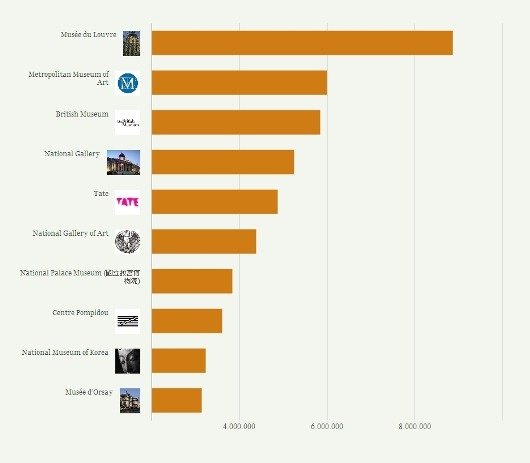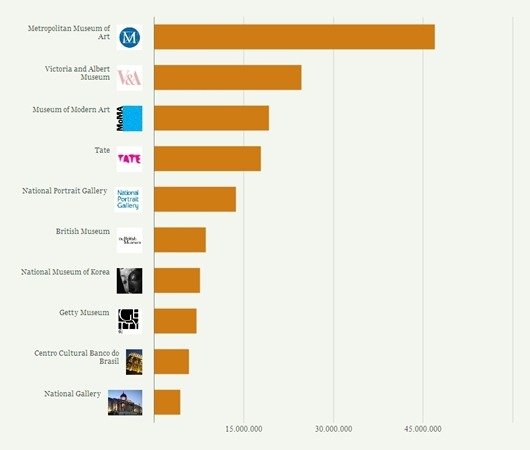Museum Next 2012 is about to start. To warm up for the conference we are publishing some posts in English about Museums, Social media and IT. Two of them will be the translation of posts we published while ago based on Museum Analytics data. The third one will be an introduction to the Mexican Suitcase blog, a project by LaMagnética for the MNAC (Catalonia’s National museum of Art).
Museum Analytics is an online project that won the People’s Choice award in Museums and the web 2012. It will be presented in Museum Next. It is an online platform for sharing and discussing information about museums and their audiences. For each museum there is a daily updated report with information about online and offline audiences: yearly museum visits, yearly web traffic, Twitter profile and number of followers, Facebook page and number of likes; along with the most engaging Facebook and Twitter content published within the last few days.
We have been playing with the values, and we have added information referring not only the number of followers in Twitter and Facebook, but we also will add Klout and SocialBro data to include the influence of the museums and their content.
This is the first post of the series, and we want to share some thoughts about the comparison of the top 10 online and offline museum lists.
10 most visited museums worldwide
Let’s start with the offline list, the 10 most visited museums worldwide in 2011. The first one is the Louvre with 8,8 million visits, and the 10th is the Prado with 2,9.

Among the top 10: 3 French museums, 3 from U.K., 2 from the USA, 1 from Korea and 1 from Spain. 7 in Europe, 2 in America and 1 in Asia.
Comparing the most visited museum list with the Top 10 online museums, we find the first interesting data: 5 of the most visited museums are also on the Top 10 online list, though in different positions. And the Louvre,the Centre Pompidou and the Orsay (all 3 in Paris), the Prado (Spain) and the National Gallery Of Art (USA), are not on the Top 10 online list.

There are also some important changes in the order:
- The Metropolitan climbs to the first position in the online ranking with a stratospheric register: 47.000.000 website visits. That is more than 100.000 a day. It almost doubles the traffic of the second one.
- The Louvre, by difference the most visited museum in the world with almost 9 million people, is not in the online list. This is probably because of a lack of data, as in 2010 it was among the 10 most visited online museums in the 6th place with about 11 or 12 million web visits. With such a traffic in 2011 it would have kept the 6th position. If it is really out of the list, then it should had dropped bellow 4,2 million website visits (this is the website traffic of the 10th place), which is unlikely.
- The British Museum drops from the 3th position (offline) to the 6ª (online). In 2010 it was 4th in the Top 10 online list.
- Tate Gallery is 4th online with almost 18 million visits.
- The Prado, climbs a step in the offline list (11th in 2010 to 10th in 2011), but drops at least two positions in the online list, and it loses some web traffic while most of the museums have increased their traffic. Last year was 9th in website traffic, this year is out of the list.
Museums top 10 online
Museums that are in the online top 10 (website), but not in the offline list (visits to the museum). These are some of the museums with a more remarkable web and social media strategy.
- The Victoria and Albert Museum received in 2011 about 2,6 million visits (12th), but it has achieved an astonishing web result, with 24,7 million visits to their website. This is a particularly interesting case, because the Victoria and Albert is a decorative arts museum, which may be a handicap for online promotion. It is necessary to find an original Search Engine Optimization approach to promote such a museum and collection, as it is not possible to use the usual approach of top Google positions for a handful of worldwide known artists (Picasso, Cezanne, Van Gogh, Dalí, etc.) that is the way contemporary art museums get many of their website visits.
It is an exception in a list copped by the big national museums (Louvre, British, Metropolitan), and contemporary art museums and art centers.
- The MOMA is not in the Top 10 most visited museums list (it was last year in the 7th place), but is the 3rd online with about 20 million visits.
- The National Portrait Gallery de Londres, is in the 5th place with 13,7 million website visits (18th offline).
- The Centro Cultural Banco do Brasil, climbs from the 14th offline place to the 8th online: 2,3 million museum visits and 5,9 website visits.
- The Getty Museum climbs from the 21th offline place to the 7th online: 21,6 million museum visits and 7,2 website visits.
In the online list we no longer find 7 European museums, there are 5 British museums, 3 from the USA, one from Brazil and One from Korea. Having English as the main language is an obvious advantage. Not to forget some very succesful web and social media strategies.
There are 5 museums that received more than 10.000.000 website visits in 2011.
In the next post we will deal with the Facebook and Twitter presence of the museums that have more than 100.000 yearly visitors. We will see that there are some useful correlations among museum visitors and Facebook likes/Twitter followers. That leads to a simple test for a museum to know how are you doing in social networks, if you are above or below to what is expected in a museum of such yearly visitors.

